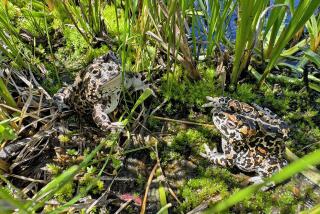Frog Die-Off Creates a Troubling Environmental Mystery
- Share via
WASHINGTON — Toads and frogs are dropping like flies.
Zoologists say a mysterious, precipitous decline in the world’s amphibian population raises troubling questions about the future of humans and the environment.
“What we’ve got here is a global early warning system and that system is the frog,” says zoologist Michael Tyler of Australia’s University of Adelaide.
So far, the evidence of a massive die-off of the world’s amphibian population is largely anecdotal, but zoologists say it should not be ignored.
“Amphibians have a perpetually moist skin, and they live both on land and in water, so they are constantly sampling their environment in ways that we don’t,” says David Wake, an evolutionary biologist at UC Berkeley.
“They are going to sense things before we do, and if they’re going to go, there’s a message there for us,” says Wake, former president of the American Society of Naturalists.
If, after further study, it is determined that the threat to amphibians is only a local problem, or part of some natural cycle, then there is nothing to worry about, Wake says.
However, if it is determined that the problem is worldwide, then something must be done, he said.
“Without question something is going on in some places. What we don’t know is if it’s general. If it is a global phenomenon, this really is an important discovery,” he said.
At Wake’s suggestion, the National Academy of Sciences in Washington has decided to sponsor a conference on the phenomenon next month in Irvine, Calif.
The goal of the session, which Wake will chair, is to determine if there is a problem and, if so, what to do about it, said National Academy staff member Donna Gerardi.
A decade ago, when Wake walked through the meadows of California’s High Sierra, “It used to be frog heaven,” he said. “They were so thick on the ground you would step on them.
“Now they are almost absent from the area,” he said.
He found a similar decimation of salamander and toad populations on a recent visit to Costa Rica’s Monte Verde rain forest, raising suspicions that the problem is widespread.
It was then that he started a “frog log” in his computer.
When his concerns began to circulate in zoological circles, the phone calls and letters started pouring in.
Areas so far reporting dwindling or disappearing amphibian populations include Denmark, Hungary, southern Ontario and Southern California as well as Australia, Wake said.
Along Australia’s east coast alone, about 20 different amphibian species have been affected “and some have disappeared entirely,” Tyler said in a telephone interview.
In Australia, New Zealand and New Guinea, “a large number of species have either disappeared totally or have disappeared from a large part of their range,” Tyler added.
While areas such as Yellowstone National Park in northwest Wyoming, central Panama and Sarawak in northern Borneo, report no apparent changes, even zoologists from these regions are unanimous in their support for a worldwide conference on the topic, Wake said.
“An investigation now is better than a funeral later,” he said.
Zoologists say there is no ready explanation for the apparent amphibian die-off.
They speculate that the causes could include pesticide residues, acid rain, a gradual disappearance of the ponds amphibians require to breed, and growing salinity in wetlands.
Other possible explanations include the contamination of wetlands with heavy metal toxins, higher doses of ultraviolet radiation from the sun (caused by a thinning of the atmospheric ozone layer), and even a lethal frog virus.
“It’s a phenomenon that can’t really be explained yet,” said Gerardi of the National Academy of Sciences.
“If the population is weakened in some way, then any of a number of things could knock them over the edge,” Wake said.






